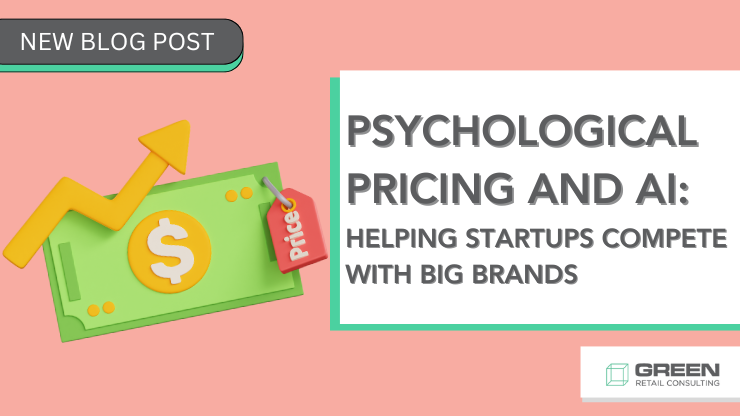Pricing is more than just numbers—it’s psychology. Businesses, both large and small, use psychological pricing strategies to influence customer behavior, maximize sales, and increase profitability. But in today's digital marketplace, AI-powered pricing tools have revolutionized the way businesses set and adjust prices in real time.
The good news? Startups can leverage strategies and tools to compete with big brands by using psychological pricing strategies and AI-powered tools to support price changes based on consumer behavior.
Psychological Pricing Strategies That Boost Sales
1. Charm Pricing (The Power of .99 and .95)
People tend to perceive prices that end in .99 as significantly lower than the next whole number. For example, $9.99 feels much cheaper than $10.00, even though the difference is only a penny. This plays on the "left-digit effect," where consumers focus more on the first digit than the last, making the price seem more attractive.
Studies have shown that prices ending in .99 can encourage consumers to make a purchase. The price appears as a "better deal," which may result in more frequent and spontaneous purchases.
Many consumers have become accustomed to charm pricing. It's so prevalent that shoppers may be more likely to trust a price that ends in .99 or .95, considering it as a standard pricing method.
While charm pricing is effective in many cases, it may not be suitable for all businesses. Luxury or high-end brands, for example, might prefer whole-number prices like $200, as it conveys a sense of exclusivity and prestige. But for most businesses aiming for mass appeal, charm pricing can be a strategic advantage.
🔨 AI-Powered Tool: Intelligems helps e-commerce brands test different price endings to determine what converts best.

“Charm pricing works, but only when it makes sense. We've tested ending prices in .99, but for premium services, whole numbers actually convert better because they feel more high-end. Bundling has been a game changer-packaging complementary services together makes it easier for clients to justify a bigger spend. Anchoring is another sneaky win. We show a high-priced option first, so the mid-tier offer feels like a deal. The best strategy? Testing everything. Pricing isn't one-size-fits-all, and small tweaks can make a huge difference in conversions.”
Founder & CEO, Prose
2. Decoy Pricing (Guiding Customers to the Best Choice)
Decoy pricing is a strategy where businesses offer a third, less attractive option to make another choice seem like a better deal. For example, a company might offer three pricing tiers: a basic option at $10, a premium option at $50, and a middle-tier option at $48. The $50 option is the "decoy," making the $48 option seem like a better value in comparison. This tactic plays on the principle of contrast, nudging customers toward the desired choice by making it appear more reasonable or cost-effective.
🔨 AI-Powered Tool: Price Intelligently helps SaaS companies structure pricing tiers based on customer data.

“At Zapiy.com, we've experimented with multiple pricing strategies, but the most effective by far has been anchoring combined with tiered pricing.
We found that when customers are presented with three pricing tiers—a basic, a mid-tier, and a premium option—they often gravitate toward the middle option. To leverage this, we structured our pricing to anchor the premium plan as the highest value (with all the bells and whistles), making the mid-tier look like the "best deal." This simple psychological shift increased our mid-tier conversions by over 30%.”
Founder/CEO, Zapiy3. Bundling (Selling More by Grouping Products)
Selling bundles leverages the power of perceived value by offering multiple products together at a discounted price. Customers feel like they’re getting more for their money, which encourages them to buy more than they originally planned. Bundling also simplifies decision-making, as it reduces the need to compare individual items. For businesses, it can increase average order value, clear out slow-moving stock, and foster customer loyalty by offering a convenient, cost-effective shopping experience.
This works particularly well in e-commerce, software, and food delivery services.
🔨AI-Powered Tool: Rebuy enables Shopify stores to create personalized product bundles using AI.

“Bundling stands out as my best pricing approach. Video content packages offered with bundled pricing helped brands grow. A package with multiple items gives customers clear value and extra options at a fair price. Sales improved after introducing these offers.
Other pricing methods like charm pricing and anchoring have merits. Testing them gave me insights that bundling delivers a clear impact. Bundle options help customers compare deals and decide. My experience shows bundled pricing grows sales by boosting customer interest and overall order value.”
UGC manager/Marketing manager, Rathly
4. Anchoring (Making Discounts Feel Bigger)
Anchoring pricing is effective because it relies on the cognitive bias where customers base their decisions on the first piece of information they encounter—the "anchor." For example, if a product is initially priced at $100 and then discounted to $70, customers perceive the $70 price as a great deal, even if it’s still higher than a similar product elsewhere. By setting a high initial price, businesses make the final price seem more attractive, driving increased sales and improving the perceived value of the offering.
🔨 AI-Powered Tool: BlackCurve automates price anchoring by dynamically adjusting original and sale prices.

“The biggest mistake people make with pricing is thinking it's about logic. It's not. It's about perception, manipulation, and control.
At American Apparel, I used *anchoring* all the time. We'd price a basic t-shirt at $24, then put a premium version next to it for $36. Suddenly, the $24 shirt felt like a steal. We weren't just selling clothes. We were selling a feeling: *Look how much you're saving.*
But the most successful? *Scarcity pricing.* We'd release "limited edition" colors or one-time-only collaborations at a slightly higher price. They sold out almost immediately. Not because they were better. Just because they were rare. People don't buy what they need. They buy what they think they might never get again.
Pricing isn't about numbers. It's about psychology. Get inside the customer's head and you can make them pay whatever you want.”
Managing Director, Insurance Panda
5. Scarcity & Urgency (FOMO Pricing)
FOMO (Fear of Missing Out) pricing is a strategy that creates urgency or scarcity, encouraging customers to make a purchase quickly before they miss out on a deal or limited availability. This can be achieved through tactics like limited-time discounts, countdown timers, or highlighting low stock levels. By tapping into the consumer’s fear of losing out on a good deal, FOMO pricing motivates faster decision-making and increases sales by leveraging a sense of urgency.
Phrases like "Only 3 Left in Stock" or "Sale Ends in 24 Hours" create a sense of urgency, triggering impulse purchases.
🔨 AI-Powered Tool: Proof uses AI to show real-time stock alerts and urgency notifications.
How AI-Powered Pricing Tools Adjust Prices Based on Consumer Behavior
AI-driven pricing models help businesses optimize prices in real-time based on consumer demand, competitor pricing, and buying patterns by using tools such as dynamic pricing, personalized pricing, and more.
1. Dynamic Pricing (Real-Time Adjustments)
E-commerce giants like Amazon adjust prices thousands of times per day based on demand. AI pricing tools allow smaller businesses to do the same.
✅ Try This: Dynamic Yield personalizes prices and promotions based on customer behavior.
2. Personalized Pricing (Tailoring Prices to Each Customer)
AI can analyze a customer’s browsing history, location, and past purchases to offer personalized discounts.
✅ Try This: Zilliant provides AI-driven personalized pricing strategies for B2B companies.
3. Competitor-Based Pricing (Staying Competitive Without a Race to the Bottom)
Startups can use AI tools to track competitors' prices and adjust their own in real-time—without undercutting profitability.
✅ Try This: Prisync automates competitor price tracking and adjustments.
4. A/B Testing for Pricing (Finding the Sweet Spot)
AI-powered A/B testing helps businesses experiment with different price points to find the one that converts best.
✅ Try This: Intelligems allows e-commerce brands to run price experimentseeeeeeeeeeee without manual guesswork.
Can Startups Compete with Big Brands Using Smart Pricing?
Absolutely! Smart pricing levels the playing field. Here’s how startups can gain a competitive edge:
🟢Use AI-Powered Pricing Tools – Leverage tools like Prisync and Intelligems to optimize pricing dynamically.
🟢 Test & Adapt Pricing Models – Run A/B tests and adjust pricing based on real-time consumer insights.
🟢 Focus on Value-Based Pricing – Instead of undercutting prices, emphasize unique brand strengths (e.g., sustainability, exclusivity).
🟢 Leverage Bundling & Subscriptions – Offer tiered pricing and bundles to increase customer lifetime value.
🟢Target the Right Customer Segments – Personalization tools like Dynamic Yield can help tailor offers to high-value customers.
By combining psychological pricing strategies with AI-powered pricing tools, startups can optimize sales and profitability—without having the budget of a big brand.
How Green Retail Consulting Can Help
We can help businesses leverage both psychological pricing and AI tools to optimize pricing strategies while aligning with sustainable practices. By combining insights into consumer behavior with AI-driven analytics, consultants can assist businesses in identifying the most effective psychological pricing techniques (like charm pricing, decoy pricing, or bundling) tailored to their target audience, particularly those interested in eco-friendly products.
AI tools can help analyze customer data, track purchasing patterns, and predict how different pricing models might influence sales for sustainable goods. This allows for dynamic pricing strategies that adjust based on demand, customer preferences, or stock levels while keeping sustainability in mind. For example, AI can identify the optimal price points that maximize profits on eco-friendly bundles or time-limited offers while ensuring that the business’s green values are communicated effectively.
Green retail consultants can also guide businesses in promoting these pricing strategies in a way that reinforces their commitment to sustainability—ensuring that eco-conscious pricing is not only effective but also aligned with brand messaging and consumer values.
Pricing is a science and an art. The right combination of psychological tactics and AI-powered tools can help businesses maximize revenue, enhance customer loyalty, and stay ahead of the competition.
Ready to optimize your pricing strategy? Contact us today to get ahead on boosting your sales today!


Leave a Comment